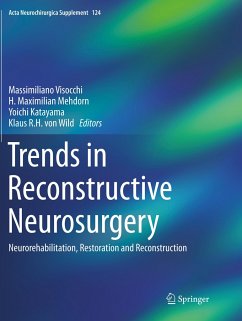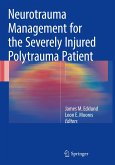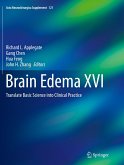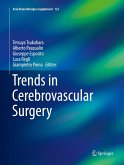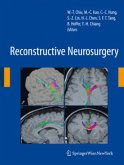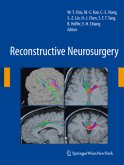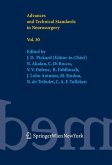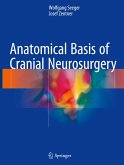Trends in Reconstructive Neurosurgery
Neurorehabilitation, Restoration and Reconstruction
Herausgegeben:Visocchi, Massimiliano; Mehdorn, H. Maximilian; Katayama, Yoichi; von Wild, Klaus R.H.
Trends in Reconstructive Neurosurgery
Neurorehabilitation, Restoration and Reconstruction
Herausgegeben:Visocchi, Massimiliano; Mehdorn, H. Maximilian; Katayama, Yoichi; von Wild, Klaus R.H.
- Broschiertes Buch
- Merkliste
- Auf die Merkliste
- Bewerten Bewerten
- Teilen
- Produkt teilen
- Produkterinnerung
- Produkterinnerung
These proceeding cover new trends presented at the IV Congress of the International Society of Reconstructive Neurosurgery (ISRN), 2015. ISRN is an "open" multidisciplinary society that deals with advances in spine and peripheral-nerve reconstructive surgery, central nervous system revascularization (surgical, radio interventional), neuromodulation, bioengineering and transplantation, which are the latest tools used to promote reconstruction, restoration and rehabilitation.
Andere Kunden interessierten sich auch für
![Neurotrauma Management for the Severely Injured Polytrauma Patient Neurotrauma Management for the Severely Injured Polytrauma Patient]() Neurotrauma Management for the Severely Injured Polytrauma Patient92,99 €
Neurotrauma Management for the Severely Injured Polytrauma Patient92,99 €![Brain Edema XVI Brain Edema XVI]() Brain Edema XVI85,99 €
Brain Edema XVI85,99 €![Trends in Cerebrovascular Surgery Trends in Cerebrovascular Surgery]() Trends in Cerebrovascular Surgery83,99 €
Trends in Cerebrovascular Surgery83,99 €![Reconstructive Neurosurgery Reconstructive Neurosurgery]() Wen-Ta Chiu / Ming-Chien Kao / Ching-Chang Hung / Shinn-Zong Lin / Han-Jung Chen / Simon F. T. Tang / Barry Hoffer / Yung-Hsiao Chiang (eds.)Reconstructive Neurosurgery211,99 €
Wen-Ta Chiu / Ming-Chien Kao / Ching-Chang Hung / Shinn-Zong Lin / Han-Jung Chen / Simon F. T. Tang / Barry Hoffer / Yung-Hsiao Chiang (eds.)Reconstructive Neurosurgery211,99 €![Reconstructive Neurosurgery Reconstructive Neurosurgery]() Reconstructive Neurosurgery211,99 €
Reconstructive Neurosurgery211,99 €![Advances and Technical Standards in Neurosurgery Vol. 30 Advances and Technical Standards in Neurosurgery Vol. 30]() Advances and Technical Standards in Neurosurgery Vol. 30113,99 €
Advances and Technical Standards in Neurosurgery Vol. 30113,99 €![Anatomical Basis of Cranial Neurosurgery Anatomical Basis of Cranial Neurosurgery]() Wolfgang SeegerAnatomical Basis of Cranial Neurosurgery136,99 €
Wolfgang SeegerAnatomical Basis of Cranial Neurosurgery136,99 €-
-
-
These proceeding cover new trends presented at the IV Congress of the International Society of Reconstructive Neurosurgery (ISRN), 2015. ISRN is an "open" multidisciplinary society that deals with advances in spine and peripheral-nerve reconstructive surgery, central nervous system revascularization (surgical, radio interventional), neuromodulation, bioengineering and transplantation, which are the latest tools used to promote reconstruction, restoration and rehabilitation.
Produktdetails
- Produktdetails
- Acta Neurochirurgica Supplement 124
- Verlag: Springer / Springer International Publishing / Springer, Berlin
- Artikelnr. des Verlages: 978-3-319-81911-2
- Softcover reprint of the original 1st ed. 2017
- Seitenzahl: 356
- Erscheinungstermin: 17. Juli 2018
- Englisch
- Abmessung: 279mm x 210mm x 19mm
- Gewicht: 972g
- ISBN-13: 9783319819112
- ISBN-10: 3319819119
- Artikelnr.: 53571322
- Herstellerkennzeichnung
- Springer Nature c/o IBS
- Benzstrasse 21
- 48619 Heek
- Tanja.Keller@springer.com
- Acta Neurochirurgica Supplement 124
- Verlag: Springer / Springer International Publishing / Springer, Berlin
- Artikelnr. des Verlages: 978-3-319-81911-2
- Softcover reprint of the original 1st ed. 2017
- Seitenzahl: 356
- Erscheinungstermin: 17. Juli 2018
- Englisch
- Abmessung: 279mm x 210mm x 19mm
- Gewicht: 972g
- ISBN-13: 9783319819112
- ISBN-10: 3319819119
- Artikelnr.: 53571322
- Herstellerkennzeichnung
- Springer Nature c/o IBS
- Benzstrasse 21
- 48619 Heek
- Tanja.Keller@springer.com
Massimiliano Visocchi is Assistant and Associate Professor in the Neurosurgical Department of the Catholic University of Rome. He is member of many neurosurgical societies and he is also involved in the board of several societies. Prof. Visocchi is the President elect of the International Society of Reconstructive Neurosurgery. He focuses on general neurosurgery and particularly in Complex Spine Neurosurgery, Central Nervous System Stimulation, Haemodynamic monitoring in neurosurgical fields and pain treatment; as well as Neurotraumatology. Prof. Visocchi has produced over 400 scientific publications (more than 200 extensive papers and book chapters in national and international scientific journals, books, congress brochures and 200 abstracts in congress brochures) and has given invited lectures in national and international congresses and courses.
Complex cervical spine reconstruction: CVJ, upper cervical spine.
Traditional skull base surgery in the era of neuroendoscopy: past or present?.
Traditional skull base surgery in the era of neuroendoscopy: what could be the role?.
Endoscopic endonasal surgery for skull base lesions: main emphasis on reconstruction.
CVJ: Transnasal approach: how, when, why?.
Transoral approach: how, when, why?.
Cranio Vertebral Junction Instrumentation and Fusion.
Thoracic spine surgery: wath's new?.
Extreme lateral transpsoas extracavitary approaches to the lumbars spine.
Intraoperative neurophysiological monitoring during spine surgery and its impact on postoperative functional outcome: state of the art and perspectives.
Motor cortex stimulation.
Corticomotor facilitation in patients with disorder of consciousness M Sarà.
Deep brain Simulation for Parkinson's Disease.
Pallidotomy: is there still a role in Parkinson disease surgery?.
Functional surgery of the brainstem: toward a new stereotaxys.
Surgical approaches to the brain stem: the role of anatomical and physiological guidance.
Vagal nerve stimulation for Epilepsy.
DBS for involuntary movement .
Deep Brain Stimulation for behavioural disorders.
Developing portable deep brain stimulation systems for small animal.
Cerebrospinal stimulation therapy for VS and MCS T.
Spinal cord stimulation for post
stroke pain.
Functional neuroaugmentative revascularization of the brain: the role of SCS. State of Art.
Bowel, bladder dysfunctions: functional neurosurgery.
Auditory functions preservation and "functional" reconstruction in acoustic neuroma surgery.
Surgical strategies for trigeminal neuralgia.
Personal Experience with 4000 Microvascular Decompression Surgeries.
Radiosurgical treatment of trigeminal neuralgia.
A New Understanding of the Offending Artery in the Mechanism of Hemifacial Spasm.
Brachial Plexus surgery.
Reconstructive neurosurgery of lumbosacral plexus traumatic lesions.
Treatment of chronic pain by peripheral nerve lesioning.
Nerve Decompression in patients with neuropathy External prosthesis complex systems to rehabilitate movements.
fMRI, pre
intra operative tractography in Neurosurgery.
The experience of Sant'Andrea Rome University Hospital.
Surgical Anatomy: the role of cadaver lab and new 3D visual systems in mapping CNS.
Peroperative and Intraoperative brain stimulation in eloquent area surgery.
Awake craniotomy combined with minimally
invasive techniques : a fair surgery approach for brain tumors.
Awake craniotomy for intracranial lesions: a proposal for a simplified intraoperative protocol.
The role of multimodal functional pre
and intraoperative imaging, mapping and neurophysiological monitoring for surgery of brain tumors located in eloquent areas.
MRI guided capsulotomy for major Psychiatric diseases.
Endoscopic reconstruction of CSF pathways in ventricular tumors P Oppido.
History of intra
extracranial vascular bypasses.
When to operate an aneurism?.
Reconstructing cerebral vessels: interventional neuroradiology.
Reconstructing cerebral vessels: neurosurgery.
Reconstruction of vascular network by radiosurgery.
aneurisms: surgical indications.
Cerebral cavernomas and surgical indications.
Complex Intracranial aneurysm.
Myth and truth in CNS radiotheraphy: controversies on vascular indications.
The impact of time, legislation and geography on the epidemiology of traumatic brain injury.
Modern research in neurotraumatology.
Post
injury hydrocephalus: the present and the future perspectives.
New Insights into the Pathophysiology and Pathobiology of Traumatic Brain Injury and Their Potential Therapeutic Modulation.
Experimental models of intracranial hypertension.
Cranial Reconstruction in head trauma.
Neurotransplantation in brain injury models.
Neurorehabilitation in brain injury.
Robotic Arm Training for stroke patients: is it more effective.
Craniofacial trauma and reconstruction: state of art.
Traditional skull base surgery in the era of neuroendoscopy: past or present?.
Traditional skull base surgery in the era of neuroendoscopy: what could be the role?.
Endoscopic endonasal surgery for skull base lesions: main emphasis on reconstruction.
CVJ: Transnasal approach: how, when, why?.
Transoral approach: how, when, why?.
Cranio Vertebral Junction Instrumentation and Fusion.
Thoracic spine surgery: wath's new?.
Extreme lateral transpsoas extracavitary approaches to the lumbars spine.
Intraoperative neurophysiological monitoring during spine surgery and its impact on postoperative functional outcome: state of the art and perspectives.
Motor cortex stimulation.
Corticomotor facilitation in patients with disorder of consciousness M Sarà.
Deep brain Simulation for Parkinson's Disease.
Pallidotomy: is there still a role in Parkinson disease surgery?.
Functional surgery of the brainstem: toward a new stereotaxys.
Surgical approaches to the brain stem: the role of anatomical and physiological guidance.
Vagal nerve stimulation for Epilepsy.
DBS for involuntary movement .
Deep Brain Stimulation for behavioural disorders.
Developing portable deep brain stimulation systems for small animal.
Cerebrospinal stimulation therapy for VS and MCS T.
Spinal cord stimulation for post
stroke pain.
Functional neuroaugmentative revascularization of the brain: the role of SCS. State of Art.
Bowel, bladder dysfunctions: functional neurosurgery.
Auditory functions preservation and "functional" reconstruction in acoustic neuroma surgery.
Surgical strategies for trigeminal neuralgia.
Personal Experience with 4000 Microvascular Decompression Surgeries.
Radiosurgical treatment of trigeminal neuralgia.
A New Understanding of the Offending Artery in the Mechanism of Hemifacial Spasm.
Brachial Plexus surgery.
Reconstructive neurosurgery of lumbosacral plexus traumatic lesions.
Treatment of chronic pain by peripheral nerve lesioning.
Nerve Decompression in patients with neuropathy External prosthesis complex systems to rehabilitate movements.
fMRI, pre
intra operative tractography in Neurosurgery.
The experience of Sant'Andrea Rome University Hospital.
Surgical Anatomy: the role of cadaver lab and new 3D visual systems in mapping CNS.
Peroperative and Intraoperative brain stimulation in eloquent area surgery.
Awake craniotomy combined with minimally
invasive techniques : a fair surgery approach for brain tumors.
Awake craniotomy for intracranial lesions: a proposal for a simplified intraoperative protocol.
The role of multimodal functional pre
and intraoperative imaging, mapping and neurophysiological monitoring for surgery of brain tumors located in eloquent areas.
MRI guided capsulotomy for major Psychiatric diseases.
Endoscopic reconstruction of CSF pathways in ventricular tumors P Oppido.
History of intra
extracranial vascular bypasses.
When to operate an aneurism?.
Reconstructing cerebral vessels: interventional neuroradiology.
Reconstructing cerebral vessels: neurosurgery.
Reconstruction of vascular network by radiosurgery.
aneurisms: surgical indications.
Cerebral cavernomas and surgical indications.
Complex Intracranial aneurysm.
Myth and truth in CNS radiotheraphy: controversies on vascular indications.
The impact of time, legislation and geography on the epidemiology of traumatic brain injury.
Modern research in neurotraumatology.
Post
injury hydrocephalus: the present and the future perspectives.
New Insights into the Pathophysiology and Pathobiology of Traumatic Brain Injury and Their Potential Therapeutic Modulation.
Experimental models of intracranial hypertension.
Cranial Reconstruction in head trauma.
Neurotransplantation in brain injury models.
Neurorehabilitation in brain injury.
Robotic Arm Training for stroke patients: is it more effective.
Craniofacial trauma and reconstruction: state of art.
Complex cervical spine reconstruction: CVJ, upper cervical spine.
Traditional skull base surgery in the era of neuroendoscopy: past or present?.
Traditional skull base surgery in the era of neuroendoscopy: what could be the role?.
Endoscopic endonasal surgery for skull base lesions: main emphasis on reconstruction.
CVJ: Transnasal approach: how, when, why?.
Transoral approach: how, when, why?.
Cranio Vertebral Junction Instrumentation and Fusion.
Thoracic spine surgery: wath's new?.
Extreme lateral transpsoas extracavitary approaches to the lumbars spine.
Intraoperative neurophysiological monitoring during spine surgery and its impact on postoperative functional outcome: state of the art and perspectives.
Motor cortex stimulation.
Corticomotor facilitation in patients with disorder of consciousness M Sarà.
Deep brain Simulation for Parkinson's Disease.
Pallidotomy: is there still a role in Parkinson disease surgery?.
Functional surgery of the brainstem: toward a new stereotaxys.
Surgical approaches to the brain stem: the role of anatomical and physiological guidance.
Vagal nerve stimulation for Epilepsy.
DBS for involuntary movement .
Deep Brain Stimulation for behavioural disorders.
Developing portable deep brain stimulation systems for small animal.
Cerebrospinal stimulation therapy for VS and MCS T.
Spinal cord stimulation for post
stroke pain.
Functional neuroaugmentative revascularization of the brain: the role of SCS. State of Art.
Bowel, bladder dysfunctions: functional neurosurgery.
Auditory functions preservation and "functional" reconstruction in acoustic neuroma surgery.
Surgical strategies for trigeminal neuralgia.
Personal Experience with 4000 Microvascular Decompression Surgeries.
Radiosurgical treatment of trigeminal neuralgia.
A New Understanding of the Offending Artery in the Mechanism of Hemifacial Spasm.
Brachial Plexus surgery.
Reconstructive neurosurgery of lumbosacral plexus traumatic lesions.
Treatment of chronic pain by peripheral nerve lesioning.
Nerve Decompression in patients with neuropathy External prosthesis complex systems to rehabilitate movements.
fMRI, pre
intra operative tractography in Neurosurgery.
The experience of Sant'Andrea Rome University Hospital.
Surgical Anatomy: the role of cadaver lab and new 3D visual systems in mapping CNS.
Peroperative and Intraoperative brain stimulation in eloquent area surgery.
Awake craniotomy combined with minimally
invasive techniques : a fair surgery approach for brain tumors.
Awake craniotomy for intracranial lesions: a proposal for a simplified intraoperative protocol.
The role of multimodal functional pre
and intraoperative imaging, mapping and neurophysiological monitoring for surgery of brain tumors located in eloquent areas.
MRI guided capsulotomy for major Psychiatric diseases.
Endoscopic reconstruction of CSF pathways in ventricular tumors P Oppido.
History of intra
extracranial vascular bypasses.
When to operate an aneurism?.
Reconstructing cerebral vessels: interventional neuroradiology.
Reconstructing cerebral vessels: neurosurgery.
Reconstruction of vascular network by radiosurgery.
aneurisms: surgical indications.
Cerebral cavernomas and surgical indications.
Complex Intracranial aneurysm.
Myth and truth in CNS radiotheraphy: controversies on vascular indications.
The impact of time, legislation and geography on the epidemiology of traumatic brain injury.
Modern research in neurotraumatology.
Post
injury hydrocephalus: the present and the future perspectives.
New Insights into the Pathophysiology and Pathobiology of Traumatic Brain Injury and Their Potential Therapeutic Modulation.
Experimental models of intracranial hypertension.
Cranial Reconstruction in head trauma.
Neurotransplantation in brain injury models.
Neurorehabilitation in brain injury.
Robotic Arm Training for stroke patients: is it more effective.
Craniofacial trauma and reconstruction: state of art.
Traditional skull base surgery in the era of neuroendoscopy: past or present?.
Traditional skull base surgery in the era of neuroendoscopy: what could be the role?.
Endoscopic endonasal surgery for skull base lesions: main emphasis on reconstruction.
CVJ: Transnasal approach: how, when, why?.
Transoral approach: how, when, why?.
Cranio Vertebral Junction Instrumentation and Fusion.
Thoracic spine surgery: wath's new?.
Extreme lateral transpsoas extracavitary approaches to the lumbars spine.
Intraoperative neurophysiological monitoring during spine surgery and its impact on postoperative functional outcome: state of the art and perspectives.
Motor cortex stimulation.
Corticomotor facilitation in patients with disorder of consciousness M Sarà.
Deep brain Simulation for Parkinson's Disease.
Pallidotomy: is there still a role in Parkinson disease surgery?.
Functional surgery of the brainstem: toward a new stereotaxys.
Surgical approaches to the brain stem: the role of anatomical and physiological guidance.
Vagal nerve stimulation for Epilepsy.
DBS for involuntary movement .
Deep Brain Stimulation for behavioural disorders.
Developing portable deep brain stimulation systems for small animal.
Cerebrospinal stimulation therapy for VS and MCS T.
Spinal cord stimulation for post
stroke pain.
Functional neuroaugmentative revascularization of the brain: the role of SCS. State of Art.
Bowel, bladder dysfunctions: functional neurosurgery.
Auditory functions preservation and "functional" reconstruction in acoustic neuroma surgery.
Surgical strategies for trigeminal neuralgia.
Personal Experience with 4000 Microvascular Decompression Surgeries.
Radiosurgical treatment of trigeminal neuralgia.
A New Understanding of the Offending Artery in the Mechanism of Hemifacial Spasm.
Brachial Plexus surgery.
Reconstructive neurosurgery of lumbosacral plexus traumatic lesions.
Treatment of chronic pain by peripheral nerve lesioning.
Nerve Decompression in patients with neuropathy External prosthesis complex systems to rehabilitate movements.
fMRI, pre
intra operative tractography in Neurosurgery.
The experience of Sant'Andrea Rome University Hospital.
Surgical Anatomy: the role of cadaver lab and new 3D visual systems in mapping CNS.
Peroperative and Intraoperative brain stimulation in eloquent area surgery.
Awake craniotomy combined with minimally
invasive techniques : a fair surgery approach for brain tumors.
Awake craniotomy for intracranial lesions: a proposal for a simplified intraoperative protocol.
The role of multimodal functional pre
and intraoperative imaging, mapping and neurophysiological monitoring for surgery of brain tumors located in eloquent areas.
MRI guided capsulotomy for major Psychiatric diseases.
Endoscopic reconstruction of CSF pathways in ventricular tumors P Oppido.
History of intra
extracranial vascular bypasses.
When to operate an aneurism?.
Reconstructing cerebral vessels: interventional neuroradiology.
Reconstructing cerebral vessels: neurosurgery.
Reconstruction of vascular network by radiosurgery.
aneurisms: surgical indications.
Cerebral cavernomas and surgical indications.
Complex Intracranial aneurysm.
Myth and truth in CNS radiotheraphy: controversies on vascular indications.
The impact of time, legislation and geography on the epidemiology of traumatic brain injury.
Modern research in neurotraumatology.
Post
injury hydrocephalus: the present and the future perspectives.
New Insights into the Pathophysiology and Pathobiology of Traumatic Brain Injury and Their Potential Therapeutic Modulation.
Experimental models of intracranial hypertension.
Cranial Reconstruction in head trauma.
Neurotransplantation in brain injury models.
Neurorehabilitation in brain injury.
Robotic Arm Training for stroke patients: is it more effective.
Craniofacial trauma and reconstruction: state of art.

